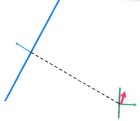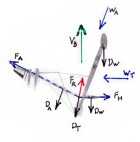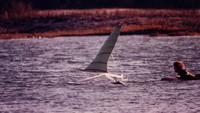High-Speed Sailing
| Vessel Name: | Sailien |
| Vessel Make/Model: | Experimental/custom |
28 September 2013
The America’s Cup
I watched, with interest, the videos of the 34th America’s Cup. At last we have fast sailboats engaged in a competition that is fun to watch. The virtual images (such as course boundaries, distance grid lines, separation between boats, etc.) overlaid on the real images really helps to keep the race [...]
31 August 2013
100 Knots for Hydroptere?
The latest news from Hydroptere is that they have plans for a 100 knot sailboat. This was posted on 26 Aug 2013, so look for that date at this address. http://hydroptere.com/en/the-news/last-news/
17 November 2012
Aptly named Sailrocket, blasts off!
While yet to be ratified, Sailrocket posted an average speed over 500 meters of 59 knots. I will not be surprised if they increase their record into the 60 knot range during this record attempt.
02 January 2012
More drag for VSR2?
I want to start by pointing out that the whole VSR2 team has done a stellar job and has demonstrated conclusively that the forces that drive a sailboat can be aligned for roll stability without using ballast and without using any down-force. (Trifoiler achieved roll stability by using down-force, but [...]
18 December 2011
My analysis of Sailrocket
I copied a diagram of VSR2 (wing doesn’t show well) and added in the major force arrows that apply. Be aware that these arrows are not correct in terms of scale (length) and some of their locations are guesses, however I believe I’m correct enough for us to learn something about what VSR2 has been [...]
23 October 2011
60 is within reach, what’s next?
I have been watching Sailrocket’s progress with great interest and there’s no question they have a winner. I fully expect to see them reach 60kt in the near future. Sailrocket has now demonstrated what I first learned with my models and again with my full-sized prototypes, that if you get the forces [...]
Monofoil
http://www.monofoil.com/boat/index.php
This is a fascinating craft; I hope it is soon completed and sailing. If you examine their website you will see that it has a leeway resisting hydrofoil to windward and a wing to leeward. Between those two is an aircraft like cockpit. Note that the leeward wing is not parallel to the hydrofoil; rather it is inclined further to windward to produce lift and raise the cockpit out of the water at speed. The advantage is that the water's drag will be reduced, but there are certain disadvantages. (This is not a criticism since any craft will be a series of compromises.)
Note that Sailrocket, Paravane and my designs set the airfoil parallel to the hydrofoil to achieve zero roll. Any craft with a kite can only achieve zero roll with the kite in one exact position. Windjet, when outfitted with a wing, shows the craft rolling to windward in order to raise the lee hull out of the water, but I don't know how that is being done.
If the airfoil is used to roll the craft to windward (Monofoil and possibly Windjet) the craft does not have true roll stability, but some means must be used to roll the craft the desired amount and no more. I suspect that for Monofoil, the pilot or co-pilot would control this function. Sailrocket uses the arm that the wing sits on, as an airfoil operating in surface effect, to roll the craft to windward and lift the lee plane out of the water at speed. I believe this is the best way to roll the craft (independent of the airfoil that drives it).
I like the fact that Monofoil is set-up to sail on both tacks. Of the recent top contenders; windsurfers, kite sailors, Longshot (Trifoiler) and Hydroptere are all capable of sailing both tacks. My own designs have always been capable of sailing both tacks and if I were involved with a speed record attempt, I would want to run a craft that could go both ways. Perhaps the rules should read that the record will be the average of a port tack and a starboard tack.
One other observation I'd like to make; note that Monofoil has its payload (skipper, etc.) between the airfoil and hydrofoil. Sailrocket, kite sailors, Le Projet Dared and Windjet, all have their payload to windward, near the hydrofoil. Paravane takes the opposite approach and has its payload to leeward, positioned with the airfoil. Paravane's approach necessitates keeping the paravane in contact with the surface of the water at all times or the craft will flip. Additionally, if the paravane is not designed to instantly shed any trash (seaweed, plastic bags, etc.) it will flip if it snags sufficient debris, since its "lift" will disappear. I watched this happen to Trifoiler; Ketterman was sailing it at speed (around 30 knots) when the windward side suddenly leapt out of the water, the craft rotated abruptly off the wind and it crashed back to the surface. I asked Ketterman what happened and he said he thought he snagged a piece of kelp (losing down-force on the windward side).
I have experimented with positioning the payload to windward (at hydrofoil) to leeward (at airfoil) and in between. While any position can be made to work, I have found the best position to be to windward. Note that if my leeway resisting hydrofoil loses "lift" by snagging trash, by pulling out of the water while going over a wave trough, or even if it breaks off, the craft will not go out of control, it will merely slide sideways. You can see a demonstration of this in my video (follow the Sailien video link).
Bob
About & Links
- Bob's Surfing Blog
- Bob's Website
- Greenbird (Windjet)
- l'Hydroptere
- Le Projet Dared
- Macquarie Speed Sailing Team
- Monofoil Sailing
- Mountain Goat STOL
- Mr Smith's Amazing Sailboats
- Patent Office (Search)
- Radboat
- Sailien Prototypes (early), Delta, etc.
- Sailien Video
- Sailien Website
- The Basics of Surfboard Design
- The Basics of Surfboard Design en Espanol
- The Swedish Speed-Sailing Challenge
- Trifoiler
- Vestas Sailrocket
- Windjet Project
- WSSRC


